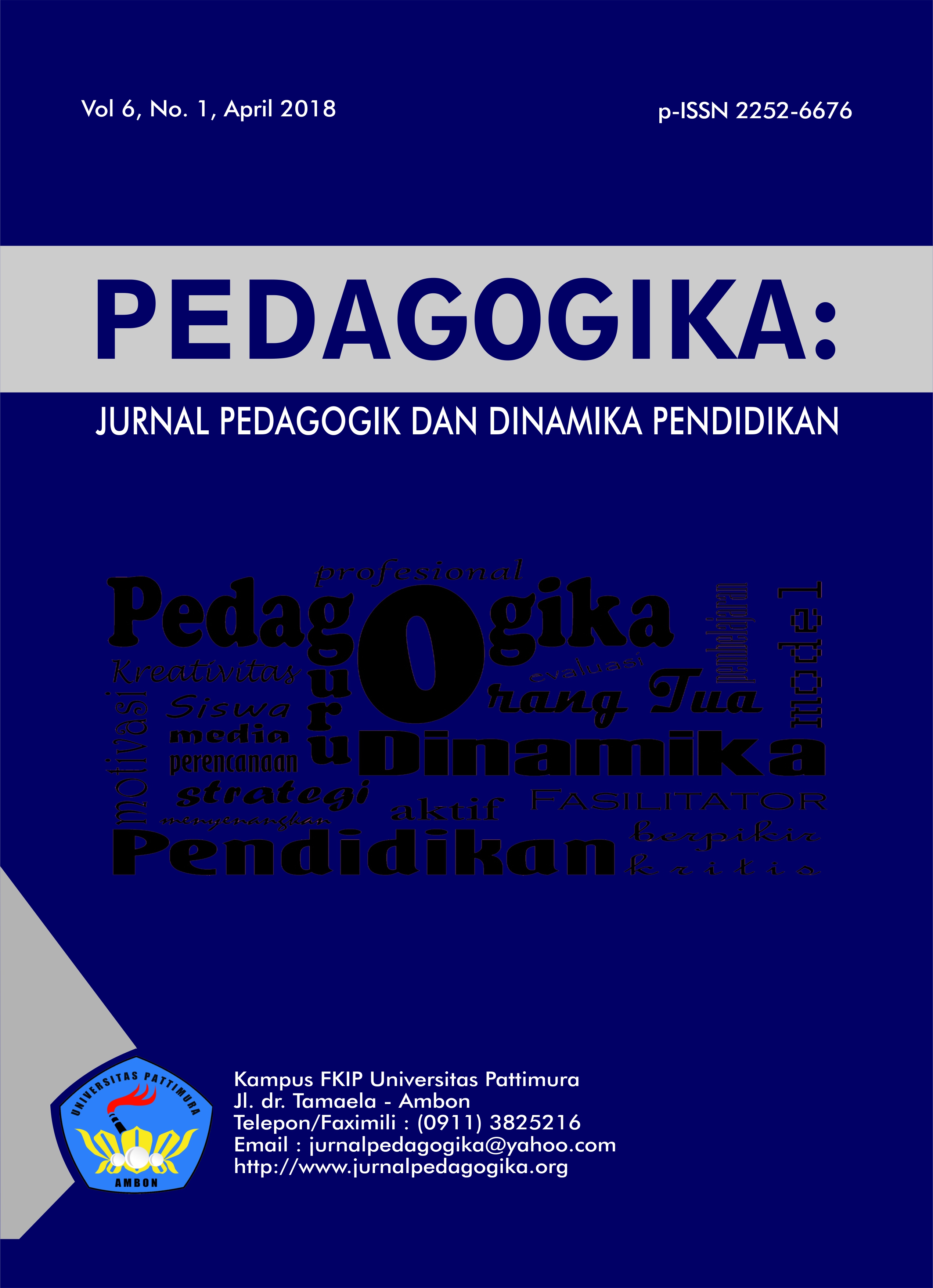PROFIL LEARNING PROGRESSION MAHASISWA CALON GURU SD TERKAIT KONSEP BENDA NETRAL SETELAH AKTIVITAS VMMSCCText
Abstract
Telah dilakukan investigasi untuk mendapatkan gambaran tentang profil learning progression mahasiswa calon guru SD setelah aktivitas Visual Multimedia Supported Conceptual Change Text (VMMSCCText). Sebelumnya, VMMSCCText telah dikembangkan untuk memfasilitasi learning progression mahasiswa calon guru SD hanya dengan membaca text. Penelitian ini bertujuan untuk mengetahui profil learning progression mahasiswa calon guru SD terkait konsep benda netral setelah mengikuti aktivitas VMMSCCText. Metode yang digunakan adalah metode deskriptif kuantitatif yang diimplementasikan pada 30 orang mahasiswa PGSD FKIP Universitas Riau pada mata kuliah Konsep Dasar IPA. Profil learning progression pada mahasiswa diinvestigasi dengan uji diagnostik dalam format four tier test (FTT) dan penilaian pada LKM, kemudian dianalisis berdasarkan tipe learning progression. Tipe learning progression terdiri dari 1) Konsisten dengan konsepsi ilmiah (Tipe I); 2) Berprogres dengan baik (Tipe II); 3) Tidak berprogres (Tipe III); dan Mengalami Degradasi (Tipe IV). Hasil penelitian dengan VMMSCCText menunjukkan tipe I sekitar 13,33%, tipe II sekitar 80%, tipe III 6,67% dan tipe IV sekitar 0%. Berdasarkan data yang diperoleh dapat disimpulkan bahwa VMMSCCText mampu meremediasi miskonsepsi dan mengembangkan learning progression mahasiswa calon guru SD.
Downloads
References
Akpinar & Tan. (2011).Developing, Implementing, And Testing A Conceptual Change Text About Relativity. Western Anatolia Journal of Educational Sciences (WAJES), Dokuz Eylul University Institute, Izmir, Turkey ISSN 1308-8971.
Aydin. (2015). Pre-service Science Teachers’ Views on Conceptual Change Strategies and Practices Carried out. International Journal of Psychology and Educational Studies, 2015, 2 (2), 21-34.
Caleon, I., & Subramaniam, R. (2010).Development and application of a three-tier test to assess secondary school students’ understanding of waves, International Journal of Science Education, 32(7), 939-961.
Cepni S, Tas E, Kose S. (2006). The effects of computer-assisted materials on students’cognative levels, misconceptions and attitudes towards science. Comp Educ 2006;46:192-205.
Chambers, S. K., & Andre, T. (1997). Gender, Prior Knowledge, Interest, and Experience in Electricity and Conceptual Change Text Manipulations in Learning about Direct Current. Journal of Research in Science Teaching, 34 (2), 107-123.
Chi, M. H., & Roscoe, R. D. (2002).Reconsidering Conceptual Change: Issues in Theory and Practice. In M. Limon, & L. Mason (Ed.), The Processes and Challenges of Conceptual Change. (pp. 3-27). Dordrecht: Kluwer Academic Publisher.
Clement, J. (1993). Using Bridging Analogies and Anchoring Intuitions to Deal with Students' Preconceptions in Physics. Journal of Research in Science Teaching, 30 (10), 1241-1257.
Dilber, R., Karaman, I., & Duzgun, B. (2009). High school students’ understanding of projectile motion concepts. Educational Research and Evaluation, 15 (3), 203-222.
Durmuş, J., & Bayraktar, Ş. (2010). Effects of Conceptual Change Texts and Laboratory Experiments on Fourth Grade Students’ Understanding of Matter and Change Concepts. Journal of Science Education and Technology , 19, 498-504.
Fulmer, G.W. (2015).Validating Proposed Learning Progressions On Force And Motion Using The Force Concept Inventory: Findings From Singapore Secondary Schools. Int J of Sci and Math Educ, 13: 1235. doi:10.1007/s10763-014-9553-x.
Gurel, D., Eryilmaz, A. & McDermott, L. (2015). A Review and Comparison of Diagnostik Instruments to Identify Students’ misconceptions in Science.Eurasia Journal of Mathematics, Science & Technology Education,11 (5), 989-1008
Gurel, D., Eryilmaz, A. & McDermott, L. (2017). Development and Application of a Four-Tier Test to Assess Pre-Service Physics Teachers’ Misconceptions about Geometrical Optics. Research in Science & Technological Education, 35 (2), 238-260
Hamid, Widodo & Sopandi.(2017). Students’ Conceptual Change in Electricity.Advances in Social Science, Education and Humanities Research (ASSEHR), volume 57.1st International Conference of Mathematics and Science Education (ICMSEd 2016).Copyright © 2017, the Authors. Published by Atlantis Press.This is an open access article under the CC BY-NC license (http://creativecommons.org/licenses/by-nc/4.0/)
Hermita, Neni. (2017). Pengembangan Visual Multimedia Supported Conceptual Change Text (VMMSCCText) Materi Kelistrikan dan Kemagnetan untuk Pengajaran Remedial Berorientasi Konstruksi-Rekonstruksi Konsepsi Ilmiah Mahasiswa Calon Guru Sekolah Dasar. Disertasi, SPs UPI. Tidak diterbitkan.
Hess, K. (2012). Learning progressions in K-8 classrooms: How progress maps can influence classroom practice and perceptions and help teachers make more informed instructional decisions in support of struggling learners (Synthesis Report 87). Minneapolis, MN: University of Minnesota, National Center on Educational Outcomes.
Hess, K. (2010). Learning Progressions Frameworks Designed for Use with the Common Core State Standards in Mathematics K-12. National Alternate Assessment Center at the University of Kentucky and the National Center for the Improvement of Educational Assessment, Dover, N.H.
İpek, H., & Çalık, M. (2008). Combining Different Conceptual Change Methods within Four-Step Constructivist Teaching Model: A Sample Teaching of Series and Parallel Circuits. International Journal of Environmental and Science Education, 3 (3), 143-153.
Mosher, Fritz. (2011). The Role of Learning Progressions in Standards-Based Education Reform. CPRE Policy Briefs . Retrieved from ttp://repository.upenn.edu/cpre_policybriefs/40
Ozkan &Selcuk. (2015).Effect of Technology Enhanced Conceptual Change Texts on Students’ Understanding of Buoyant Force. Universal Journal of Educational Research 3(12): 981-988, 2015 http://www.hrpub.org . DOI: 10.13189/ujer.2015.031205.
Pesman, H., & Erylmaz, A. (2010).Development of a three-tier test to assess misconception about simple electric circuit. The Journal of Educational Research, 103(3), 208-222.
Plummer, J, D. (2015).Embodying the Earth’s place in the solar system: Students investigating seasonal constellations. Science and Children, 53 (4), 52-61.
Posner, G.J., Strike, K.A., Hewson, P.W., dan Gertzowg, W.A. (1982). Accomodation of a scientific conception: Toward a theory change. Science Education,Vol 66, 211-227.
Roth, K. J. (1985). Conceptual Change Learning and Students' Processing of Science Text.Annual Meeting of the American Education Research Association. Chicago.
Şahin, Ç., İpek, H., & Çepni, S. (2010). Computer Supported Conceptual Change Text: Fluid Pressure. Procedia Social and Behavioral Sciences, 2, 922-927.
She H, Lee CQ. (2008). SCCR Digital learning sytem for scientific conceptul(a change and scientific reasoning. Comp Educ 2008;51:724-742.
Sinclair Kesley J, Renshaw CE & Taylor HA. (2004). Improving computer assisted instruction in teaching higher order skills. Comp Educ 2004;42:169–180.
Stepans, S. (1994). Targeting students’ science misconceptions: Using the conceptual change model. Idea Factory. Inc. Riverview, FL: U.S.A.
Stepans, S. (2011, 3rd ed.). Targeting students’ science misconceptions: Using the conceptual change model. Sticlound, MN. Saiwood Publications.
Sugiyono.(2013). Metode Penelitian Pendidikan (Pendekatan Kuantitatif, Kualitatif, dan R&D). Penerbit Alfabeta: Bandung
Taşlıdere, E., & Eryılmaz, A. (2009). Alternative to Traditional Physics Instruction: Effectiveness of Conceptual Physics Approach. Eurasian Journal of Educational Research (35), 109-128.
Thompson, J., Braaten, M., Windschitl, M., Sjoberg, B., Jones, M., & Martinez, K. (2009). Examining Student Work: Evidence-based learning for students and teachers. The Science Teacher, 76(8), 48-52.[Diakses pada 18 Februari 2015]
Tippett, C. D. (2010). Refutation Text in Science Education: A Review of Two Decades of Research. International Journal of Science and Mathematics Education, 8, 951-970.
Torija, B & Aleixandre, MP. (2017). Developing an Initial Learning Progression for the use of Evidence in Decision-Making Context. Int J Sci and Math Educ.
Windschitl M. (2001). Using simulations in the middle school: Does assertiveness of dyad partners influence conceptual change? Int J Sci Educ 2001;23:17-32









 This work is licensed under
This work is licensed under 